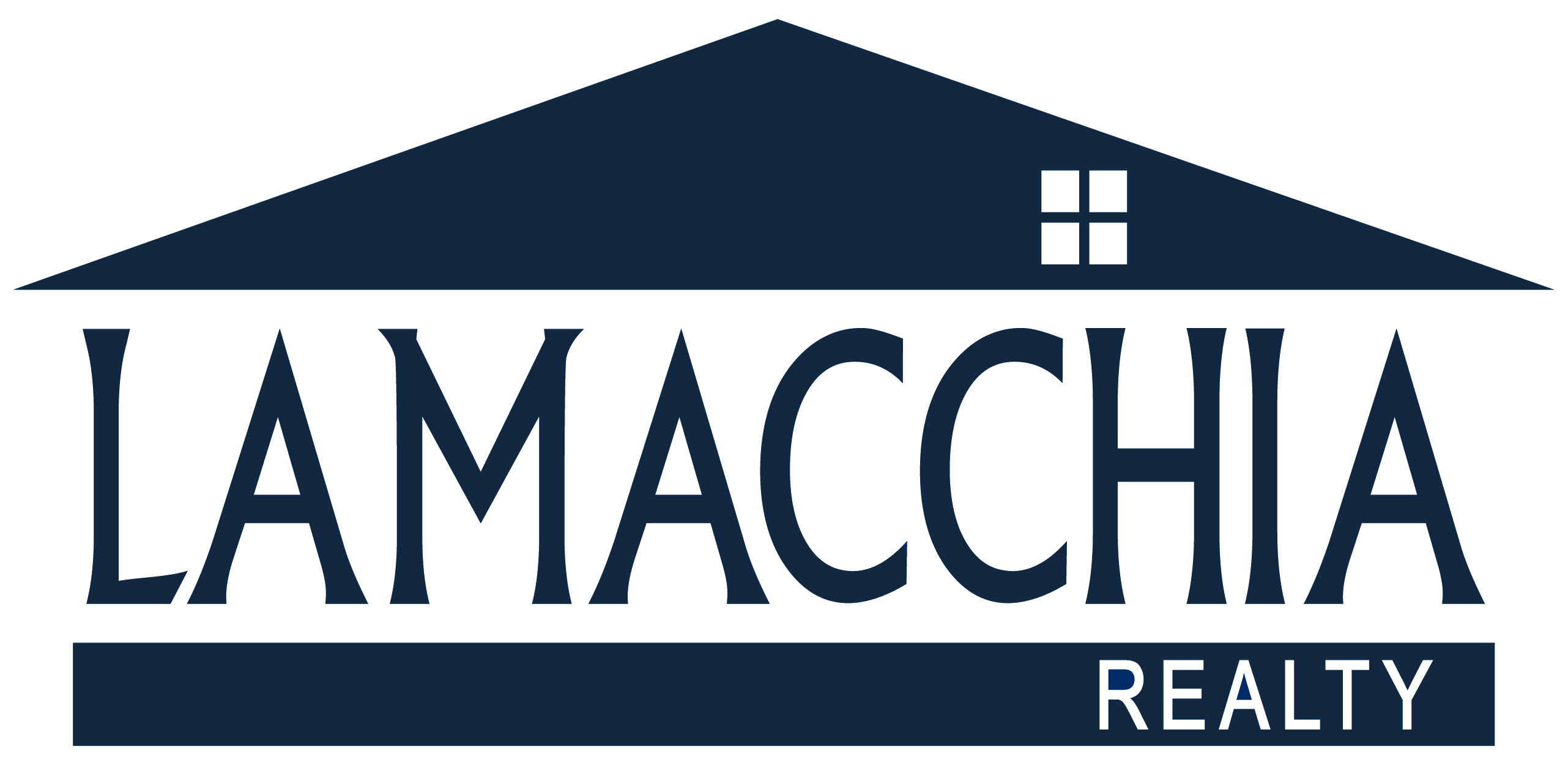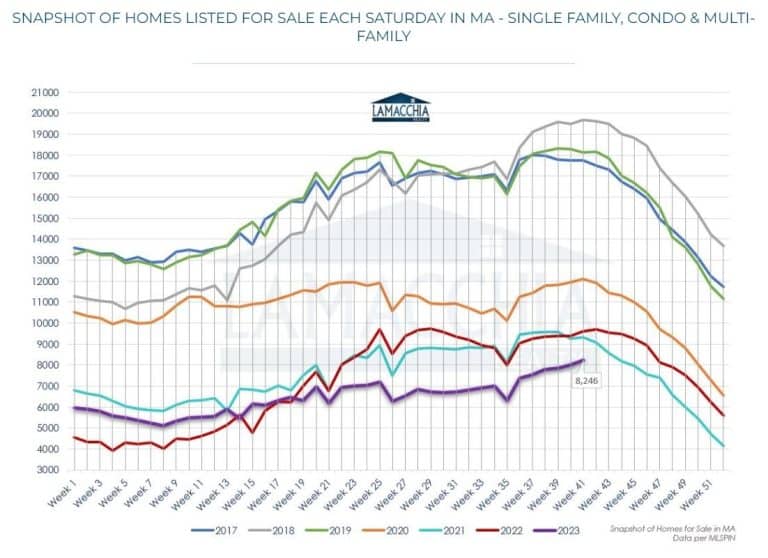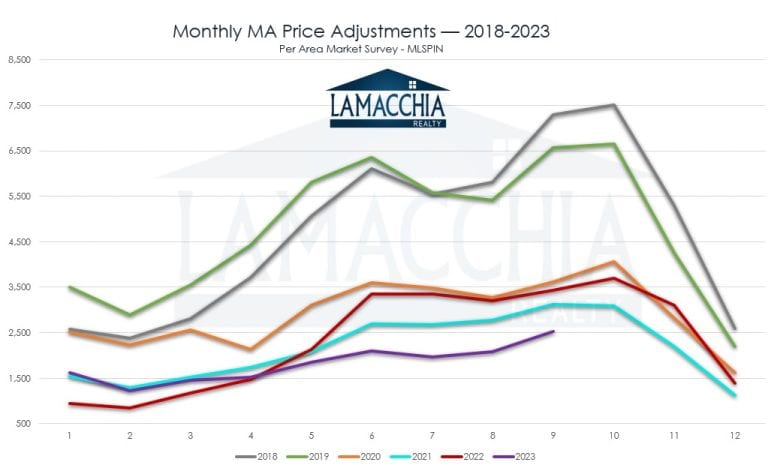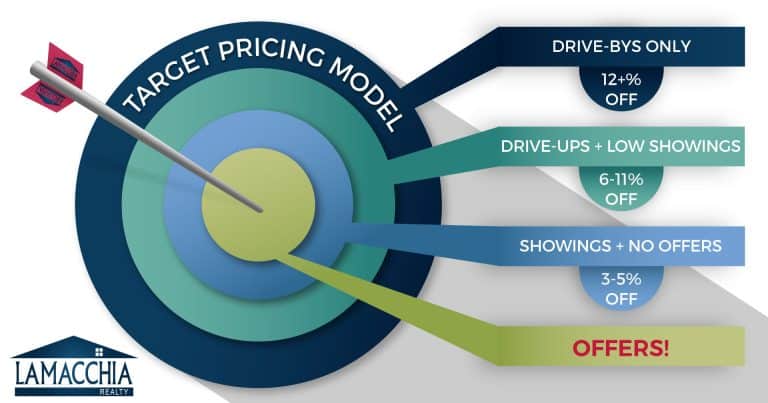
In March 2022, it was clear that the market was changing from a frenzied post-pandemic scene to one where it was assumed that rising mortgage rates would slow it down and help inventory finally rise back up. Now, a year and a half later, with rates up to 8%, buyer affordability is significantly diminished. Furthermore, potential sellers with covid-era mortgage rates of around 3% aren’t actually listing because it means they’d have to give up that historic rate and trade it in for one that is two to three times higher. The first quarter of 2023 had the lowest number of homes listed in recorded history.
Inventory didn’t increase at the rate most assumed it would. Coming from the frenzied pandemic market where inventory was at historically low levels, sellers are holding the line and buyers are still the ones competing in this market. The lack of inventory has prevented prices from falling so buyers are dealing with both rising prices and higher rates. Buyers used to be able to handle the rising prices of homes because rates were so low, but now with rates hovering in the 8% range, it costs a lot more to borrow.
Sales are down as a result of the current market conditions and consumers dealing with the challenges of inflation and uncertainty related to global events. Additionally, it’s hard for most people to wrap their heads around a rate that is basically 5% higher than it was a couple years ago. In the graph below, you can see 2022 started with the highest absorption rate with the red line higher than the rest. Right around late spring/early summer, the line started to fall beneath the prior year, and it stayed that way. The purple line represents this year and continues to land beneath the previous two years until around late spring/early summer and is now riding a little higher than last year. With sales down that means even though buyers are still buying and rapidly consuming available inventory, the number of homes listed isn’t enough to keep sales numbers higher than last year as there just aren’t enough homes for buyers to purchase.
Driving that point home, the graph below indicates that the number of homes for sale every Saturday has been lower every year since the pandemic started. Inventory began to rise in mid-2022 and again, many assumed that inventory would continue to rise, but with rates skyrocketing, the opposite started to happen, around the same time the absorption rate started rising in late spring/early summer. Since then, the number of homes for sale has been lower than any of the previous years.
So, what does all of this mean for price adjustments? It means they’re down.
Fewer sellers need to adjust their price because, again, it’s a seller’s market. That said, if a home has been listed and isn’t selling that means the list price is too high. Sellers create demand with accurate pricing and aggressive marketing. If their home is placed on the market with a high list price, it will sit and a price adjustment will be the first step in attracting more buyers.
 Typically, it would take more inventory than buyers to shift from a seller’s market to a buyer’s market, and this usually happens in the second half of the year. In the graphic to the right, you can see this more clearly. It’s a sellers’ market in the beginning of the year with lower inventory than the number of buyers, but by fall, the number of buyers drops below the number of sellers, and it therefore becomes a buyers’ market. Sellers then become the ones who need to compete.
Typically, it would take more inventory than buyers to shift from a seller’s market to a buyer’s market, and this usually happens in the second half of the year. In the graphic to the right, you can see this more clearly. It’s a sellers’ market in the beginning of the year with lower inventory than the number of buyers, but by fall, the number of buyers drops below the number of sellers, and it therefore becomes a buyers’ market. Sellers then become the ones who need to compete.
This year, we are still in a seller’s market where buyers are the ones that need to compete for homes due to the low inventory, and if they’re priced out in a bidding war, two things happen. The first is that the losing buyers are still out there consuming whatever is listed keeping demand high, and the second is that the high price of the sale due to the bidding war is keeping prices from dropping.
We have been telling buyers for years now that there is a cost of waiting to buy; prices have continued to rise, and rates couldn’t possibly have stayed at the historic lows we were seeing. Here we are. The same, however, will be true for sellers. There will be a cost of waiting to sell when the tides turn.
June has historically been when we see the first peak in price adjustments, with the largest number generally occurring in the fall. 2018 and 2019 depict the paths of what was a ‘typical’ market prior to the pandemic. 2020 and 2021 did see slight hills and valleys but nothing as intense as the years’ prior. 2022 exhibited a rise in the number of price adjustments year over year in June and stayed higher than 2021 for the rest of the year. 2023 began with price adjustments up over the same period the previous year, but then in April dropped and has stayed lower than previous years. September saw an uptick but not enough to reach the number of adjustments in the previous year. This uptick shows that we are at the highest number of adjustments this year. Rates are high, buyer affordability is lower than ever, and for those sellers that need to sell, they need to market their home to buyers by making their home affordable. The more affordable the home is to more buyers, the more demand is created for the home, and buyers will compete for it resulting in a multiple offer situation.
It comes with a negative stigma for sellers to hear that a price adjustment is recommended. But if the home has been available long enough, it’s time to consider adjusting the list price to gain more visibility from more potential buyers.
An experienced REALTOR® will make it very clear from the beginning that pricing right is the key to selling faster and for more money. But even with all the data at hand, determining the exact price isn’t always easy, especially in a shifting market like we have seen since the beginning of the year. There are factors such as comparable active properties, time of year, recently sold properties in your area, condition of the property, and current market conditions to take into consideration when pricing a home. Even if the home is priced appropriately, the market could shift quicker than anticipated and a price adjustment may be the next best step. As well, looking at a home in which the offer was accepted in January will not have a comparable list price to a similar home listed now as the market is different.
How do you know your house is overpriced?
1. Your home is priced much higher than properties in your area
Your REALTOR® will complete a comparative market analysis of the homes sold in your area in the past 2-3 months. This is a common method to determine the target price range for your home. Neighborhood homes are valued relatively close to one another if their size and condition are relatively similar. If you price your home even 5% over the rest, your home may be overlooked. This is a strong sign that a price adjustment is in order.
2. Infrequent showing requests
The first thing that buyers see when they browse homes for sale besides pictures, is the list price. If that price doesn’t reflect the images of the home and the area, they’re not going to bother to come see it. If you don’t have any requests for showings and if an open house yields an underwhelming crowd, you should review your list price and lower it to attract more buyers. Remember, buyers determine what they can afford based on what their monthly payment will be, not total mortgage, so as a seller it helps to get a sense of what a buyer will have to spend every month to own your home.
3. A few weeks goes by without an offer
Due to the inventory levels this past winter and spring, many homes sold for over asking in multiple offer situations. If your home has been on the market without any strong offers, it may not be priced correctly. In typical real estate markets, a seller should receive at least one offer within the first two weeks of listing the home. If three weeks go by, contact your REALTOR® to discuss an adjustment on the list price.
4. You hired the agent who recommended the highest price
It’s not necessarily wise to go with the REALTOR® who said to list your home for the highest number. That could be a sign that they’re not fully understanding the market in your area and that they may underdeliver. Make sure you fully grasp why your REALTOR® suggests the price that they do by asking them to show you comps in your area that have sold recently and that are currently active on the market. If their price is outlying the comps, you’re risking the loss of a fast and strong sell price.
When and how much should you adjust the price?
If you’re questioning whether it’s time to adjust, then it’s time to adjust. If three weeks go by without a strong offer or a decent response to the listing, adjust the price. There’s no sense in delaying the inevitable and the sooner that you attract more buyers, the sooner you’re likely to receive requests for showings and offers.
Lamacchia Realty has been selling homes since 2005 and tracking data to develop an effective model on pricing homes. The Lamacchia Realty Target Pricing Model has been implemented in the selling process since 2007.
Despite an earnest attempt at correctly pricing at the start, adjustments may have to be made on the list price to attract more interested buyers, as previously explained. You’ll see in the graphic below how to determine the level of reduction that needs to be made.
You can see that if you accurately priced your home, you are in the bullseye and receiving strong offers. If not, the areas around the bullseye will tell you roughly how much of an adjustment is recommended.
Get Your Price on Target
- If your home is receiving showings but no offers, somewhere between a 3-5% adjustment should be made.
- If you’re receiving a small number of showings and only some drive ups, you probably need somewhere between a 6-11% adjustment.
- Not getting any showings at all is a red flag that at least a 12% adjustment is necessary. When this happens, sellers are usually the most hesitant to adjust because they just cannot believe no one has even come out to see the house.
There are factors and variables involved in a price adjustment that your experienced Realtor will be able to review with you.
Consider the Price Bracket
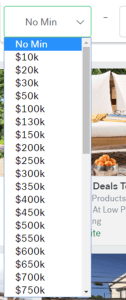 Along with comps and the Target Pricing Model, price brackets are a helpful tool to use when adjusting the price of your home. Simply put, lowering your price to the next bracket will expose your home to those people searching within that next price range.
Along with comps and the Target Pricing Model, price brackets are a helpful tool to use when adjusting the price of your home. Simply put, lowering your price to the next bracket will expose your home to those people searching within that next price range.
Real estate websites set up their property search tools with price brackets. The person searching for a home will select the area, the number of beds, baths and as well, their price range. If your home is currently listed at $475,000, everyone searching for homes in the $450K to $500K range will see it, but you’re missing every person searching for homes under $450K.
The limitation with only following the Target Pricing Model is that if you are on the market at $429,000 and you adjust your price by say 5%, you will end up at an adjusted price of $407,550. If that is what the target pricing model calls for you can do it but, in this case, it would be a lot smarter to shift down to $400,000 so that you can reach new buyers. Your home will fall into two brackets, the $350K to $400K as well as the $400K to $450K, if they’re in $50K increments. Although you’re listing for $7,550 less, you may receive multiple offers which could develop a bidding war. Bidding wars generally get homes sold for over asking, so you could theoretically make that money up in the end.
To illustrate this scenario, we went into MLS and utilized the “Marketing Overview” feature which tells you how many additional matches you will receive from lowering the price.
From the image below, if the current list price of $475,000 was reduced by 5%, the new price would be $451,250. In the red text, you’ll see that by this reduction, the sellers will attract 70 more people. Please also note that the home will remain in its current bracket of $450K to $500K.
From this image below, however, you’ll see that if the current list price of $475K was reduced $1,250 more than that initial 5% reduction, the seller’s home would attract almost 400 buyers! For that small amount of money, 323 additional people will be reached than if the reduction was limited strictly to 5% which attracted just 70. Now, this home is in two price brackets, the $400K to $450K as well as the $450K to $500K.
When a listing in MLS has a price change, agents are notified as well as buyers with saved searches that match the home’s criteria. If the listing in this example actually changed their price to $450,000, 393 active buyers would be notified that this home is available to be purchased as well as agents. This is an incredibly effective way to gain interest in a listing that has otherwise sat on the market without much of a response.
Final Thoughts
In the book Zillow Talk by Spencer Rascoff and Stan Humphries Chapter 15 talks about Pricing. One of the points they make is about price adjustments. They say, “If you overprice it’s better to admit your mistake and cut the price all the way down to the true market value in one fell swoop.” They are right.
Sellers tend to see a lot of value in their home and lowering the list price can feel as if they are telling people that the home is less valuable. That is an emotional response to a business transaction, and although understandable, it’s not going to achieve the bottom line of selling the home for as much money as possible.
If you are a seller who is at the point where buyers aren’t biting, lowering the price is the fastest way to attract buyers and more demand.
As mentioned in our previous blog, there are 5 considerations when pricing a home. Exploring comparative sold properties, the market climate when those comps were sold, comparative active properties, the current inventory and the current market. Even if the seller and their experienced agent do their best to price well, it may become evident that an adjustment is in order after a few weeks. Using the target pricing model and revisiting those 5 considerations along with paying attention to the price bracketing will help refocus that target price and get your home sold.
